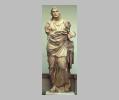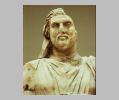
"Mausolus", frontal view

"Mausolus", detail of upper torso and head
| Collection: | London, British Museum |
| Title: | "Mausolus" |
| Context: | From Halikarnassos |
| Findspot: | Excavated at Halikarnassos |
| Summary: | Standing draped male figure |
| Object Function: | Funerary |
| Material: | Marble |
| Sculpture Type: | Architectural |
| Category: | Statuary group |
| Placement: | Other sculpture in the round |
| Style: | Late Classical |
| Technique: | In-the-round |
| Original or Copy: | Original |
| Date: | ca. 350 BC |
| Dimensions: | H (excluding base) 3.01 m, H (head from chin to crown) 0.39 m, H (chin to top of forehead) 0.31 m, L (right foot) 0.48 m |
| Scale: | Over life-size |
| Region: | Caria |
| Period: | Late Classical |
Subject Description:
The figure stands facing front, the weight on the right leg. The head, which was carved separately, is tilted slightly to the proper right and down. The left arm was held against the body to the elbow, with the forearm extended. The left hand held a scabbard for a sword. The position of the right arm, which was carved separately and is missing in its entirety, is less clear. The figure is heavily swathed in drapery, consisting of two garments. The full-length tunic — Waywell suggests it may be the Asiatic surma — is pinned on each shoulder, from which point broadly-spaced pleats descend over the chest. The voluminous himation is folded over, gathered under the left arm, passed around the body and up over the left shoulder in back, from which it drops down the left side of the figure. On the feet are laced sandals with thick soles, which are worn over a sock.
The face is that of a man of middle age, with features that convey the impression of a highly individualized portrait, and one that does not attempt to idealize the physical appearance of the man portrayed. He has a low and extremely broad brow, marked by a deep furrow which emphasizes the strong bulge over the nose and eyes. The long nose is joined to the forehead by a high, wide bridge. The eyes are set deep into the head and are widely spaced. Deep age lines separate the cheeks from the mouth. He wears a mustache and short beard. The long hair is brushed straight back from the forehead and allowed to fall down the shoulders.
Following the discovery of the figure by Newton, it was identified as Mausolus and attributed to the chariot group which was placed on the top of the tomb. The identification was based largely on the discovery of several fragments of the chariot and horses in the same area. The large female figure found close by was identified as Artemisia and also assigned to the chariot. The association with the chariot group is now usually rejected, notably by Waywell who published the free-standing sculpture of the Mausoleum. He cites the following reasons for disassociating these two figures: 1) the findspot does not provide solid evidence for the original position of the sculpture on the building, 2) the scale of the figures is too small in comparison with the horses and 3) there are a number of fragments of similarly large figures (a minimum of eleven), far too many to be associated with the chariot. He believes that all these figures belong to a series of portraits of individuals connected with the Hecatomnid dynasty (to which Mausolos belonged), and that they were placed in the intercolumniations of the Ionic peristyle high on the building. Whether or not the identification of the figure as Mausolus need also be rejected is a different, and still much debated, matter.
Form & Style:
The free-standing figures such as this one probably stood between the columns of the Ionic peristyle.
Date Description:
Mausolus died in 353 BC. Artemisia, who is mentioned prominently in connection with the building of the Mausoleum, died in 351 BC. The building was said to be incomplete at the time of her death. The dynasty came to an end not long after. Thus the likelihood that the project continued well into the 340s is not great. On the other hand, the Mausoleum was clearly provided for in the plan of the city, a project which should probably be attributed to Mausolus himself. The building was not necessarily begun during his lifetime, but it may have been. Since it is not known how long it took to complete the building, a date around the middle of the 4th century is the closest which can be determined.
Condition: Nearly complete
Condition Description:
The statue has been reconstructed from more than 70 fragments. The major elements which are missing include: upper left part of the head (not affecting the face), right arm, much of the left arm, left foot, some of the drapery, particularly that which falls from the left arm. The surface is heavily weathered on the top of the head and back of the shoulders (the latter probably caused by water running off the head); the lower part of the statue is less weathered.
Material Description:
Pentelic marble (?Waywell)
Technique Description:
Head and right arm carved separately. Back roughly finished.
Associated Building: Halikarnassos, Maussolleion
Collection History: Excavated in 1957 by Newton; part of the large sculpture deposit north of the north peribolos wall.
Sources Used: